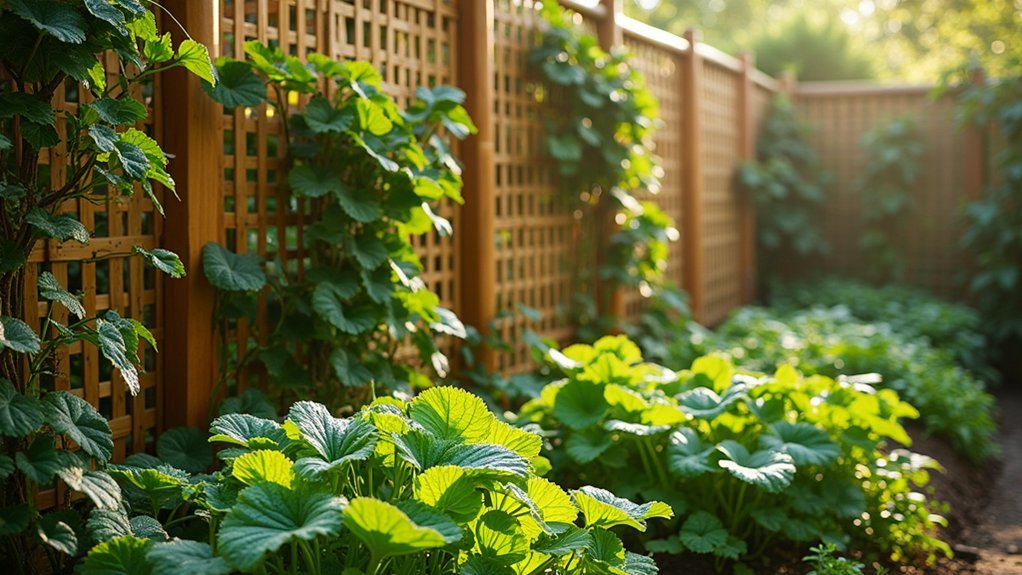Transform your garden boundaries into productive growing spaces with these vertical fence solutions: multi-tiered pallet wood fencing with built-in herb shelves, recycled plastic and wire mesh systems for climbing vegetables, and sustainable cedar or bamboo barriers that protect against animals while supporting plants. You’ll maximize your growing area without expanding horizontally—perfect for small yards or urban gardens. These eco-friendly designs turn ordinary boundaries into thriving edible landscapes that serve multiple functions.
Multi-Tiered Pallet Wood Fencing With Integrated Herb Shelves

While traditional garden fencing merely divides spaces, multi-tiered pallet wood fencing transforms your garden’s vertical boundaries into productive growing zones.
You’ll maximize your growing area without expanding horizontally, perfect for small yards or urban gardens.
Start by disassembling pallets into uniform boards, then attach them to sturdy posts, guaranteeing adjacent sections butt tightly together for stability.
Sand rough edges and apply weather sealant to extend durability.
The beauty of this design lies in its integrated shelving—perfect for herb containers or small flowering plants. By configuring different sections at various heights, you can create a multi-bin system that accommodates plants with different sunlight requirements.
This eco-friendly solution repurposes materials that might otherwise end up in landfills.
You’ll enjoy the rustic aesthetic, functional growing space, and budget-friendly approach while supporting biodiversity in your garden.
Regular maintenance guarantees your vertical garden thrives season after season.
Recycled Plastic and Wire Mesh Climbing Support Systems
Recycled plastic and wire mesh systems represent another innovative approach to vertical gardening that complements wooden pallet designs.
You’ll find bi-oriented polypropylene nets particularly effective for supporting climbing vegetables during windy conditions, while being UV-resistant and reusable for multiple seasons.
For a more permanent solution, consider stainless steel wire nets that provide excellent structural support while ensuring proper air circulation.
Products like Tenax HORTONOVA offer revolutionary design for cut flowers and climbing vegetables with optimized mesh sizes (typically 150mm x 150mm) to accommodate extensive foliage. When installing vertically, these nets can be fastened to posts spaced 3-5 meters apart along your plant rows for optimal support.
Don’t overlook creative recycling options—repurposed bike rims and bed frames can become unique trellises, while wood-plastic composite materials offer durability without rot concerns.
Choose from various colors (green, black, white) to either blend with your garden aesthetic or create visual contrast.
Sustainable Cedar and Bamboo Living Barriers With Animal Protection

Cedar and bamboo stand out as premier materials for creating sustainable living barriers that protect your edible garden from unwanted animal visitors. These naturally pest-resistant woods offer durability while minimizing environmental impact.
For effective protection, build your fence at least 6 feet high to deter jumping animals. Consider integrating cedar posts with wire mesh for enhanced security without compromising aesthetics. Bamboo’s dense packing creates an impenetrable barrier against smaller critters. Vertical gardening concepts can be incorporated into your fence design to maximize growing space while maintaining protective functionality.
Transform your fence into a productive space by training edible climbers like green beans, which also fix nitrogen in your soil. Strawberries, grapes, kiwi, and blackberries can all thrive on these structures, providing both food and privacy.
The thorny nature of blackberries adds an extra defensive layer while still yielding delicious harvests.
Frequently Asked Questions
How Do I Protect Vertical Gardens Against Harsh Weather Conditions?
You’ll need to install removable shade cloth for summer heat and frost protection covers during winter. Don’t forget to add mulch for insulation and maintain proper air circulation by spacing plants adequately.
Can Vertical Fences Accommodate Irrigation Systems for Automatic Watering?
Yes, you can easily integrate irrigation systems into vertical fences for automatic watering. Drip systems work especially well, delivering water directly to plant roots while conserving water and reducing your maintenance needs.
What’s the Optimal Spacing Between Plants on Vertical Structures?
Space plants based on their specific needs: vining plants like cucumbers need 8-12 inches, strawberries 6-8 inches, and herbs 4-6 inches. You’ll want to take into account mature size and growth habits for ideal yields.
How Much Weight Can Different Fence Materials Safely Support?
Chain link fences support 500-1000 lbs but distribute weight poorly. Steel panels handle 800+ lbs with proper footings. Wooden structures manage 200 lbs on 4×4 posts. Hybrid systems offer the best capacity at 1200+ lbs.
Are There Portable Vertical Fence Options for Rental Properties?
Yes, you’ll find several portable vertical fence options ideal for rentals. Modular panels, chain link with privacy screens, and freestanding systems with blocks can be easily installed and removed without permanent alterations to the property.
In Summary
Vertical fencing isn’t just a boundary—it’s an opportunity to maximize your edible garden’s potential. Whether you’ve chosen the multi-tiered pallet design, recycled plastic mesh systems, or sustainable cedar barriers, you’ll enjoy more growing space, better protection, and enhanced garden aesthetics. By implementing these smart vertical solutions, you’re transforming ordinary boundaries into productive growing zones while creating a more sustainable and efficient food garden.





Leave a Reply